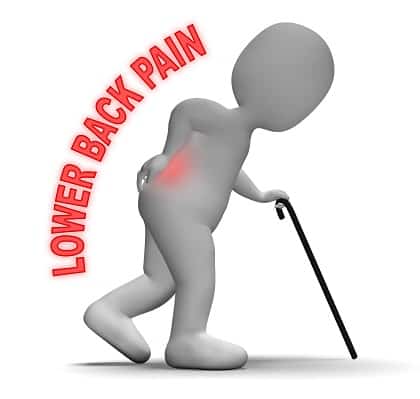Lower Back Pain Treatment

What is lower back pain?
Lower back pain is linked to a muscle strain or sprains caused by a fall, injury or sudden movement. The majority of people experience lower back pain (of varying degrees) at some point in their lives.
In most cases, it is not serious and you wouldn’t know the exact cause of the pain. Often, lower back pain gets better within a few days without any medications or treatments just by keeping active and performing light and simple exercises. This can relieve the pain and heal your back within a few days.
Did you know that having lower back pain is one of the most common reasons for having to take time off work?
Although the lower back (also known as lumbar spine) is a comprehensive and well-designed structure that gives you support and strength, it is also vulnerable to injury which causes lower back pain.
In some cases, taking painkillers can help the pain disappear within a couple of weeks. If the pain continues, further investigation and treatment may be needed.
If it doesn’t get better on its own, you may need to see a doctor or back specialist to identify its causes and effective treatments. Surgery is rarely needed to treat lower back pain.
If lower back pain is neglected, it may lead to a long term disability.
The cause and treatment for lower back pain is often unclear to patients. This is where a spinal surgeon comes in.
A spinal surgeon will do a thorough analysis and examination in order to rule out any serious causes of lower back pain. This helps in offering reassurance that the individual is not at any serious risk and is unlikely to harm his/her back while performing their daily activities.
What are the causes of lower back pain?
Lower back pain can happen suddenly, or can develop slowly over time. Here are the most common causes of lower back pain:
- Muscle or ligament strain by over-stretching (pulling), heavy lifting, twisting the spine while lifting, vigorous exercise at the gym or a sudden awkward movement.
- Sciatica (bulging or ruptured disks) can be another cause for lower back pain. This happens when a weakened and bulging disk is pressed against the sciatic nerve; this can cause intense pain which goes down one leg. This cause can be confirmed by having a spine X-rays.
- Spinal Stenosis – This happens when the space around the spinal cord narrows and puts a pressure on the spinal nerves.
- Prolonged periods of time incorrectly sitting at your desk (poor posture) can also cause lower back pain.
- Herniated disc and Spondylolisthesis (vertebra slides out of position) are other causes of lower back pain.
What are the symptoms of lower back pain?
Lower back pain symptoms can be mild or severe. In most cases, lower back pain starts suddenly and gets worse if not treated. These symptoms can be a dull and aching pain or stabbing sensation. It limits your mobility (i.e. stop you from bending, moving, standing up or other daily activities). Lower back pain can worsen if you sit or stand for a long period of time. Lying down can help ease the pain.
Lower back pain is classed as chronic if it lasts for more than 2 or 3 months. If it doesn’t ease up within a few days, it is advised to see a doctor. This would also apply if you experience lower back pain due to a fall or injury, and accompanied by bowel or bladder control problems, weakness and numbness in the legs, having a fever, or getting pain while coughing or peeing.
Identifying lower back pain symptoms and get them diagnosed at early stages can minimise your recovery time and also avoid any damage to your back.
Lower back pain diagnoses.
Identifying the best treatment for lower back pain depends on making a correct clinical diagnosis that identifies the underlying cause of lower back pain.
The initial diagnostic process is when an orthopaedic doctor is provided with all accurate and detailed symptoms the patient is having and also his/hers medical history records. From the supplied information, the doctor may then be able to have an idea for the cause of the patient’s lower back pain.
Here are some of the diagnostic questions that an Orthopaedic doctor would ask the patient:
- Type of pain and when did it start?
- Did the pain start slowly and got worse over a period of time?
- Do you feel the pain when lying down?
- Any chronic conditions?
- Is the pain bad when you wake up in the morning or after you finish work?
- Is the pain mainly at the lower part of your back?
- Do you have any numbness? If so, where about?
- When sitting at a desk, do you use a comfortable chair and sit upright?
- Have you had any back injuries? If so, what kind of treatment have you had?
As well as the initial diagnostic process, physical examination of the lower back is required. This will narrow down possible causes and determine where the pain is coming from. Some of these examinations are:
- Check for any muscle tightness, tenderness or joints/disks abnormalities in the lower back area.
- Check movement of the patient’s back, hip, legs and knees, as well as bending and twisting of the lower back, raising the legs while lying down. This will determine where the pain is and how bad it is in certain positions.
- Check legs reflexes and look for weakened reflexes.
X-rays, CT scan and MRI may also be needed if the initial diagnostics, patient’s history records and physical examination were not sufficient to identify the cause of the lower back pain.
What are the treatments for Lower Back Pain?
Most lower back pain settles down after a short period of time and can be treated with rest and pain killers. Sometimes it helps with manipulation treatment. If that fails, then further investigation and referral to a spinal surgeon is needed.
Treatments for lower back pain vary depending on the symptoms, cause and how long the patient had the pain. Below is a list of treatments in the order of symptoms severity.
- Light daily exercises including walking and stretching (with short rests in between).
- Massage
- Physiotherapy
- Medication
- Acupuncture
- Steroid injections
- Surgery
In most cases, a combination of the above treatments would be prescribed by the doctor to cure lower back pain.
Researchers found that doing the 1st three treatments mentioned above (exercises, stretching and massage) would speed up the patient’s recovery and ease lower back pain.
If the cause for lower back pain is muscle strain, it is recommended that you do your normal daily activities, as sleeping or lengthy bed resting can make the pain worse.
The most important thing is to remain active (as much as you can tolerate) and avoid any strenuous activities that make the pain worse as this may cause further damage to your back. You can try some of your normal daily activities but stop as soon as you feel it is making your lower back pain worse. Don’t do any activity that causes you pain!
Some of these activities are stretching your lower back muscles, hip, and legs. Light aerobic exercises, having a warm bath and using a hot water bottle or heating pad can also help the flow of blood into the affected area, ease up the pain and speed up the healing process. These activities can also improve your flexibility and posture, and strengthen your back muscles.
For mild lower back pain, pain-relieving cream or anti-inflammatory medications such as aspirin or ibuprofen can ease your lower back pain caused by inflamed nerves or muscles. As for severe or chronic pain, you may need prescribed medication.
If the lower back pain becomes worse or persists after a few weeks, you should consult a doctor.

